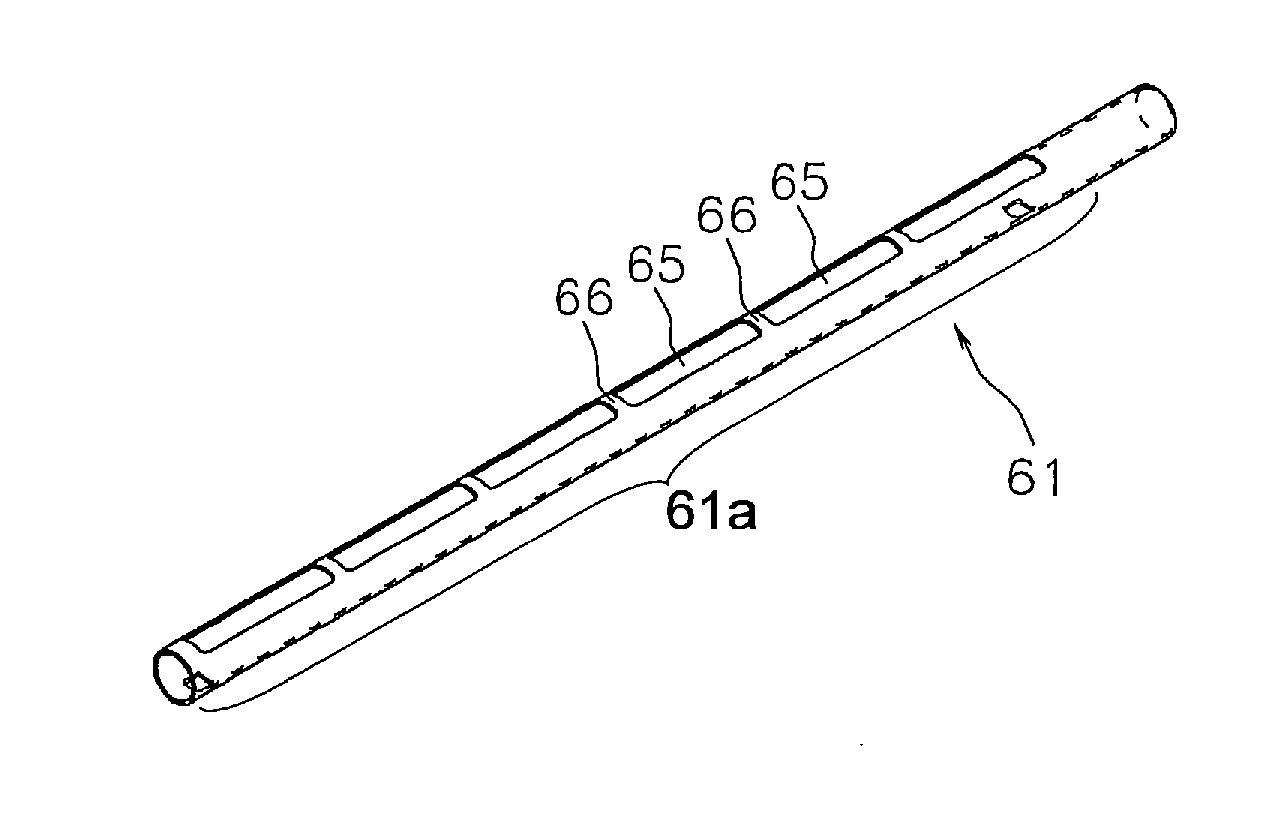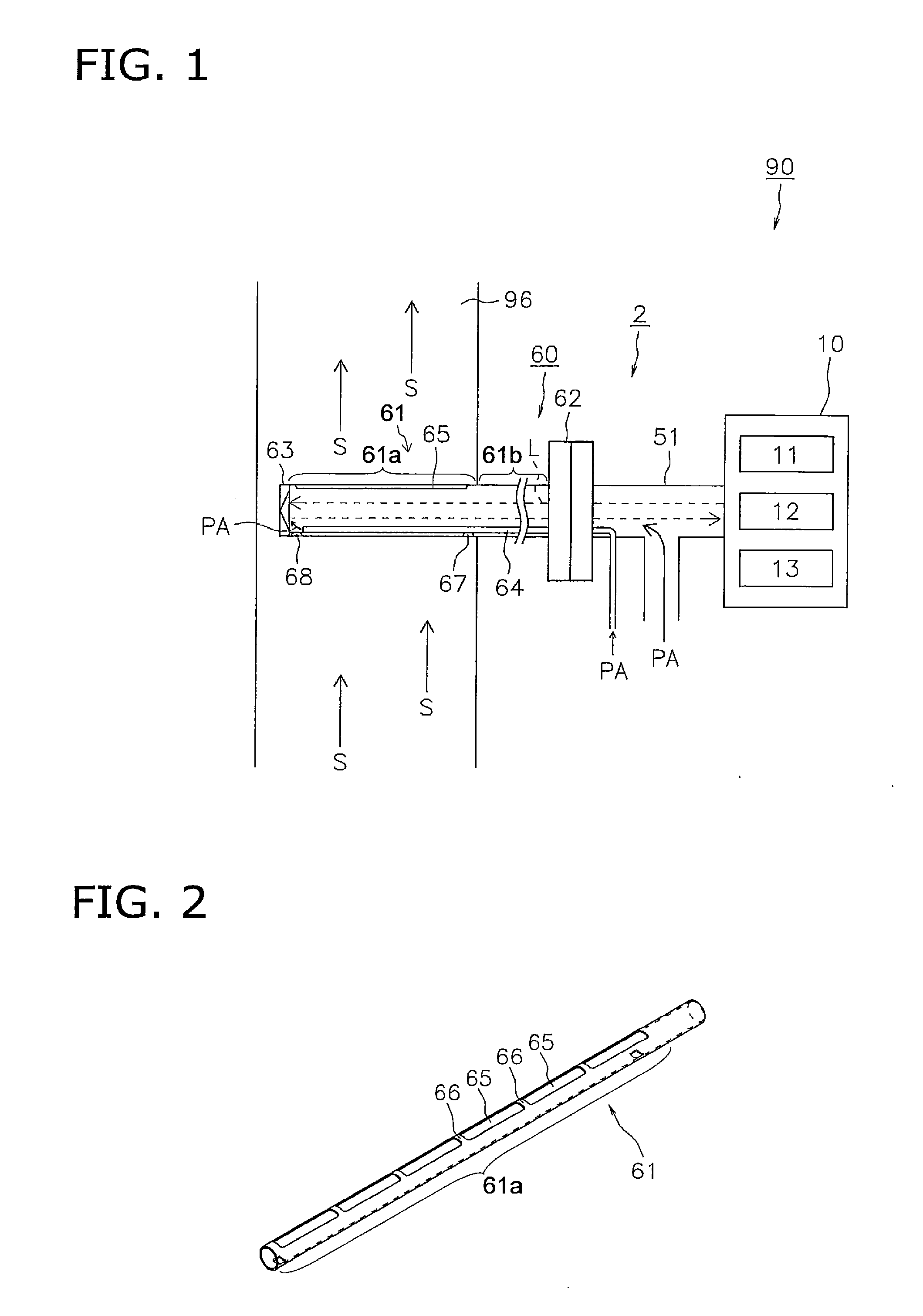Probe for gas analysis
- Summary
- Abstract
- Description
- Claims
- Application Information
AI Technical Summary
Benefits of technology
Problems solved by technology
Method used
Image
Examples
first embodiment
1. First Embodiment
[0024]Hereinafter, one embodiment according to the present disclosure will be explained with the accompanying drawings.
[0025]FIG. 1 is a block diagram for illustrating an optical analyzer including a probe for gas analysis according to an embodiment of the present invention. FIG. 2 is a perspective view of a tubular member of the probe shown in FIG. 1. FIG. 3A is a plan view of the tubular member shown in FIG. 2, FIG. 3B is a transverse sectional view of the tubular member, and FIG. 3C is a rear view of the tubular member.
[0026]An optical analyzer 90 according to the embodiment includes a measuring device 10 and an analysis unit 2. The measuring device 10 is a typical one including a light source 11 (e.g., laser or LED) for emitting a measurement light, a light detecting unit 12 (e.g., a photodiode), and a control unit 13. The control unit 13 controls actions of the light source 11 and the light detecting unit 12, and calculates the density of the analyzed object ...
second embodiment
2. Second Embodiment
[0048]The probe for gas analysis may be formed with small openings on the upstream side. Hereinafter, this embodiment will be explained.
[0049]FIG. 7 is a plan view of a probe for gas analysis according to another embodiment. A probe for gas analysis 70 shown in FIG. 7 is formed with a plurality of small holes 71 on its upstream side. Between the plurality of small holes 71, predetermined gaps are formed. The probe 70 is formed with openings (not shown) along the effective cell length on the downstream side, similar to those in the probe 60 (see FIG. 2). The above-described openings on the downstream side will not be explained hereinafter because they have already been explained.
[0050]The diameter of the small holes 71 has a size such that the dust D flowing into the probe along with the sample gas S does not substantially affect the measurement. The diameter, the number, spaces or intervals, or the like of the small holes 71 may be adjusted so as to be within pre...
third embodiment
3. Third Embodiment
[0052]The probe for gas analysis may be provided with a cover that opens and closes the openings formed on the downstream side along the effective cell length. Hereinafter, this example will be explained referring to FIG. 8 and FIG. 9.
[0053]FIG. 8A and FIG. 8B are longitudinal sectional views of a probe for gas analysis according to another embodiment. A probe for gas analysis 74 shown in FIG. 8A and FIG. 8B illustrates a structure in which a tubular member 76 is disposed within and in contact with the tubular member 61 of the probe 60 shown in FIG. 1, and the tubular member 76 is formed with openings 75 along an entire surface on one side. The tubular member 76 corresponds to the above-described cover. In an optical analyzer including the probe 74 as shown in FIG. 8A, when the openings 75 of the tubular member 76 and the openings 65 of the tubular member 61 form a positional relationship in which they are communicated with each other, the sample gas S is measured...
PUM
 Login to View More
Login to View More Abstract
Description
Claims
Application Information
 Login to View More
Login to View More - R&D
- Intellectual Property
- Life Sciences
- Materials
- Tech Scout
- Unparalleled Data Quality
- Higher Quality Content
- 60% Fewer Hallucinations
Browse by: Latest US Patents, China's latest patents, Technical Efficacy Thesaurus, Application Domain, Technology Topic, Popular Technical Reports.
© 2025 PatSnap. All rights reserved.Legal|Privacy policy|Modern Slavery Act Transparency Statement|Sitemap|About US| Contact US: help@patsnap.com



